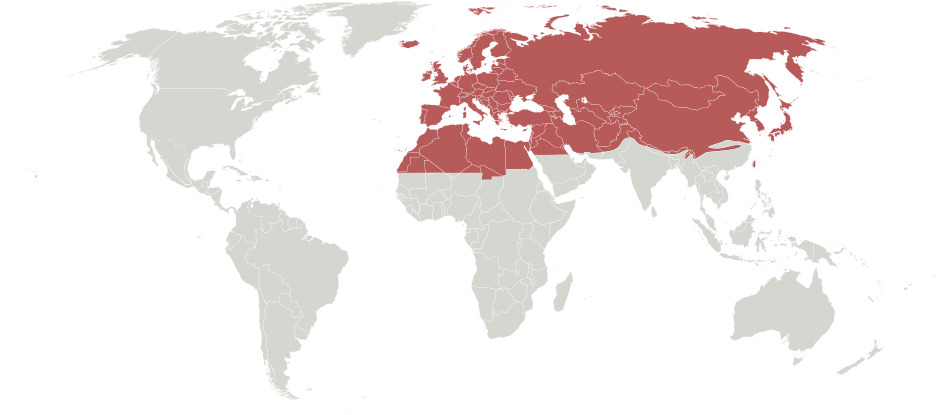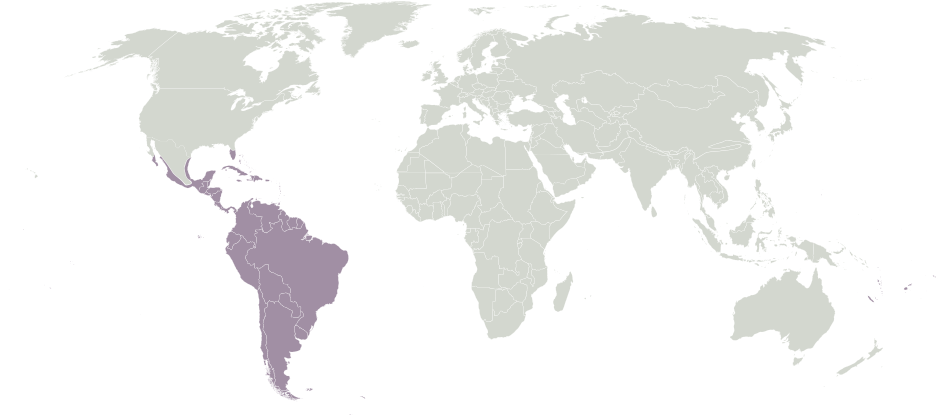Family: Megachilidae
Subfamily: Megachilinae
Tribe: Megachilini
Genus: Megachile Latreille, 1802
Subgenus: Chrysosarus Mitchell, 1943
Common name: none
Megachile (Chrysosarus) have black integumentintegument:
a tough, protective outer layer
and can have reddish, tan, gray, or yellow hairs that often form apicalapical:
near or at the apex or end of any structure
bands on their tergaterga:
the segments on the top side of the abdomen, often abbreviated when referring to a specific segment to T1, T2, T3, T4, T5, T6, or T7 (Michener 2007Michener 2007:
(Michener 2007Michener 2007:
Michener, C.D. 2007. The Bees of the World (2nd ed.). Johns Hopkins University Press, Baltimore and London, 953 pp.). They range in body length from 8–17 mm (Michener 2007Michener 2007:
Michener, C.D. 2007. The Bees of the World (2nd ed.). Johns Hopkins University Press, Baltimore and London, 953 pp.).
(modified from Michener 2007Michener 2007:
Michener, C.D. 2007. The Bees of the World (2nd ed.). Johns Hopkins University Press, Baltimore and London, 953 pp.; Gonzalez 2008Gonzalez 2008:
Gonzalez, V.H. 2008. Phylogeny and classification of the bee tribe Megachilini (Hymenoptera: Apoidea: Megachilidae), with emphasis on the genus Megachile. Thesis: Department of Ecology and Evolutionary Biology and the College of Liberal Arts and Science of the University of Kansas: 1-274.; Praz 2017Praz 2017:
Praz, C.J. 2017. Subgeneric classification and biology of the leafcutter and dauber bees (genus Megachile Latreille) of the western Palearctic (Hymenoptera, Apoidea, Megachilidae). Journal of Hymenoptera Research 55: 1-54.)
 with incomplete apicalapical:
with incomplete apicalapical: straight in profile.
straight in profile. preapicalpreapical:
preapicalpreapical:Male Megachile (Chrysosarus) may be confused with bees in the subgenus Megachile (Zonomegachile) since they both have three-toothed mandibles, enlarged front tarsitarsi:
the group of segments at the end of the leg following the tibia
, a spine on the fore coxacoxa:
the basal segment of the leg, and the T6T6:
the segments on the top side of the abdomen, often abbreviated when referring to a specific segment to T1, T2, T3, T4, T5, T6, or T7 has a preapicalpreapical:
has a preapicalpreapical:
referring to a section of a bee that is physically found just before the outermost (or apical) end of the section or segment
carinacarina:
a clearly defined ridge or keel, not necessarily high or acute; usually appears on bees as simply a raised line
with a strong median emarginationemargination:
a notched or cut out place in an edge or margin, can be dramatic or simply a subtle inward departure from the general curve or line of the margin or structure being described
(Michener 2007Michener 2007:
Michener, C.D. 2007. The Bees of the World (2nd ed.). Johns Hopkins University Press, Baltimore and London, 953 pp.). Male M. (Chrysosarus), however, lack the strong hypostomalhypostomal:
the notched region underneath the head and behind the mandible that holds the folded tongue
projection at the mandibularmandibular:
near the mandible
base that is present in M. (Zonomegachile). Female Megachile (Chrysosarus) can be differentiated from Megachile (Zonomegachile) by the lack of cutting edges on the mandiblemandible:
bee teeth, so to speak, usually crossed and folded in front of the mouth (Michener 2007Michener 2007:
Michener, C.D. 2007. The Bees of the World (2nd ed.). Johns Hopkins University Press, Baltimore and London, 953 pp.).
Megachile (Chrysosarus) have been observed visiting the flowers of Asteraceae, Convolvulaceae, Fabaceae, Hydrophyllaceae, Lamiaceae, Lythraceae, Malvaceae, Onagraceae, Oxalidaceae, Passifloraceae, Ranunculaceae, Rubiaceae, Solanaceae, Verbenaceae, and Zygophyllaceae (Raw 2006Raw 2006:
Raw, A. 2006. A new subgenus and three new species of leafcutter bees, Megachile ( Austrosarus ) (Hymenoptera, Megachilidae) from central Brazil. Zootaxa 1228(1): 25-34.; Raw 2007Raw 2007:
Raw, A. 2007. An annotated catalogue of the leafcutter and mason bees (genus Megachile ) of the Neotropics. Zootaxa 1601: 1-127.).
Megachile (Chrysosarus) nests are constructed out of chewed leaves in pre-existing cavities (Laroca 1971Laroca 1971:
Laroca, S. 1971. Notas sôbre a nidificação de Chrysosarus tapytensis Mitchell (Hymenoptera, Apoidea). Boletim da Universidade Federal do Paraná, Zoologia 4: 39ndash;44.; Laroca et al. 1992Laroca et al. 1992:
Laroca, S., E. Corbella, and G. Varela. 1992. Biologia de Dactylomegachile affabilis (Hymenoptera: Apoidea): 1. Descriccedil;aacute;o do ninho. Acta Biologia Paranatense [Curitiba] 21: 23-29.; Zillikens and Steiner 2004Zillikens and Steiner 2004:
Zillikens A. and J. Steiner. 2004. Nest architecture, life cycle and cleptoparasite of the Neotropical leaf-cutting bee Megachile ( Chrysosarus ) pseudanthidioides Moure (Hymenoptera: Megachilidae). Journal of the Kansas Entomological Society 7: 193ndash;202.). Brood cells differ from other Megachile subgenera in that they contain a layer of mud between layers of petals and leaves (Laroca et al. 1992Laroca et al. 1992:
Laroca, S., E. Corbella, and G. Varela. 1992. Biologia de Dactylomegachile affabilis (Hymenoptera: Apoidea): 1. Descriccedil;aacute;o do ninho. Acta Biologia Paranatense [Curitiba] 21: 23-29.; Raw 2007Raw 2007:
Raw, A. 2007. An annotated catalogue of the leafcutter and mason bees (genus Megachile ) of the Neotropics. Zootaxa 1601: 1-127.). Megachile (Chrysosarus) have been observed nesting in bamboo, bramble, wood, galls, trap nests, bromeliad leaves, the abandoned nests of digger bees (Centris) and potter wasps (Eumenidae), and in cane roofs of houses (Raw 2007Raw 2007:
Raw, A. 2007. An annotated catalogue of the leafcutter and mason bees (genus Megachile ) of the Neotropics. Zootaxa 1601: 1-127.).
Megachile (Chrysosarus) consists of fifty-six species (Raw 2007Raw 2007:
Raw, A. 2007. An annotated catalogue of the leafcutter and mason bees (genus Megachile ) of the Neotropics. Zootaxa 1601: 1-127.); none are known to occur in the U.S. or Canada.
There are no known invasives.
Megachile (Chrysosarus) occurs predominantly in South America where they are found in Guyana, Peru, Brazil, Paraguay, Argentina, and Panama (Raw 2007Raw 2007:
Raw, A. 2007. An annotated catalogue of the leafcutter and mason bees (genus Megachile ) of the Neotropics. Zootaxa 1601: 1-127.).

Distribution map generated by Discover Life -- click on map for details, credits, and terms of use.
Laroca, S. 1971. Notas sôbre a nidificação de Chrysosarus tapytensis Mitchell (Hymenoptera, Apoidea). Boletim da Universidade Federal do Paraná, Zoologia 4: 39–44.
Laroca, S., E. Corbella, and G. Varela. 1992. Biologia de Dactylomegachile affabilis (Hymenoptera: Apoidea): 1. Descriçáo do ninho. Acta Biologia Paranatense [Curitiba] 21: 23-29.
Michener, C.D. 2007. The Bees of the World (2nd ed.). Johns Hopkins University Press, Baltimore and London, 953 pp.
Praz, C.J. 2017. Subgeneric classification and biology of the leafcutter and dauber bees (genus Megachile Latreille) of the western PalearcticPalearctic:
the largest biogeographic region; consists of Europe, Asia north of the Himalaya foothills, Northern Africa, and the northern and central parts of the Arabian Peninsula (Hymenoptera, Apoidea, Megachilidae). Journal of Hymenoptera Research 55: 1-54.
(Hymenoptera, Apoidea, Megachilidae). Journal of Hymenoptera Research 55: 1-54.
Raw, A. 2006. A new subgenus and three new species of leafcutter bees, Megachile (Austrosarus) (Hymenoptera, Megachilidae) from central Brazil. Zootaxa 1228(1): 25-34.
Raw, A. 2007. An annotated catalogue of the leafcutter and mason bees (genus Megachile) of the Neotropics. Zootaxa 1601: 1-127.
Zillikens A. and J. Steiner. 2004. Nest architecture, life cycle and cleptoparasitecleptoparasite:
bees that lay their eggs in the nest cells of bees in other genera. Their larvae depend on the pollen provided by their host. Since cleptoparasitic bees don't provision their own nests, and instead depend on the pollen collected by their host, the females lack pollen collecting hairs. This often gives them a wasp-like appearance.
of the NeotropicalNeotropical:
biogeographic region that includes South and Central America, the Caribbean Islands, southern Florida, and the southern Mexican lowlands leaf-cutting bee Megachile (Chrysosarus) pseudanthidioides Moure (Hymenoptera: Megachilidae). Journal of the Kansas Entomological Society 7: 193–202.
leaf-cutting bee Megachile (Chrysosarus) pseudanthidioides Moure (Hymenoptera: Megachilidae). Journal of the Kansas Entomological Society 7: 193–202.